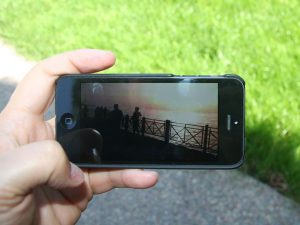On iOS devices Splice is the best free video editor. It’s easy-to-use interface makes it easy to create a short documentary.
- Download and install the app.
- To start a new project, just push the „plus“-symbol in the top right corner.
- Splice is openening your media library. Per fingertip you can add your recordings to your Splice-project. The chronological order is irrelevant. You can arrange and reorder the clips in your project however you want.
- After everything is imported you can edit your video or its audio track. I recommend to start with video editing. Reorder the videos, trim and cut your clips and choose a transistion. I don’t use transitionson video clips.
- Tap the video clip you want to edit and push the „edit“-button
- After the clip opens in a new window, you can trim and cut the clip, apply effects and filters, change its playback speed, add a text overlay, apply a zoom effect and set volume levels for each clip in your project.
- When you’ve finished this, you can edit the audio track of the video. Go to the Audio tab.
- Splice comes with four audio tracks. The top audio track is reserved for audio that is embedded into a video component. The other two audio tracks can be used to include songs and/or special sound effects. You can add multiple files to each track.
- One audio track is filled with the clips, two used for music, while another for speech, and another for fx. With the last audio track you directly record a voice-over in the timeline.
- When everything is completed, you can export the whole video into multiple files with different resolutions including HD (1080P & 720P).
- Now you can easily upload the video to Youtube, or save back to your camera roll for uploading wherever you wish.
How to find music
Finding free, legal music for your online videos can be difficult. Please always respect the license conditions of the contributors. Here are some sources:
Workshop: How to make a short documentary with a smartphone

Part 1: The best apps for making videos
Part 2: Mobile journalism must haves
Part 3: General filming tips
Part 4: Michael Rosenblum’s “five shot” method for meaningful video sequences
Part 5: Tips for shooting dynamic video interviews
Part 6: Working with video apps
Part 7: How to make a documentary
Part 8: Further reading
